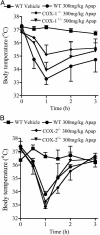Acetaminophen-induced hypothermia in mice is mediated by a prostaglandin endoperoxide synthase 1 gene-derived protein
- PMID: 15263079
- PMCID: PMC503757
- DOI: 10.1073/pnas.0404185101
Acetaminophen-induced hypothermia in mice is mediated by a prostaglandin endoperoxide synthase 1 gene-derived protein
Abstract
Acetaminophen is a widely used antipyretic analgesic, reducing fever caused by bacterial and viral infections and by clinical trauma such as cancer or stroke. In rare cases in humans, e.g., in febrile children or HIV or stroke patients, acetaminophen causes hypothermia while therapeutic blood levels of the drug are maintained. In C57/BL6 mice, acetaminophen caused hypothermia that was dose related and maximum (>2 degrees C below normal) with a dose of 300 mg/kg. The reduction and recovery of body temperature was paralleled by a fall of >90% and a subsequent rise of prostaglandin (PG)E(2) concentrations in the brain. In cyclooxygenase (COX)-2(-/-) mice, acetaminophen (300 mg/kg) produced hypothermia accompanied by a reduction in brain PGE(2) levels, whereas in COX-1(-/-) mice, the hypothermia to this dose of acetaminophen was attenuated. The brains of COX-1(-/-) mice had approximately 70% lower levels of PGE(2) than those of WT animals, and these levels were not reduced further by acetaminophen. The putative selective COX-3 inhibitors antipyrine and aminopyrine also reduced basal body temperature and brain PGE(2) levels in normal mice. We propose that acetaminophen is a selective inhibitor of a COX-1 variant and this enzyme is involved in the continual synthesis of PGE(2) that maintains a normal body temperature. Thus, acetaminophen reduces basal body temperature below normal in mice most likely by inhibiting COX-3.
Figures






References
-
- Roberts, L. J., II & Morrow, J. D. (2001) in The Pharmacological Basis of Therapeutics, eds. Hardman, J. G., Limbird, L. E. & Gilman, A. G. (McGraw–Hill, New York), pp. 687–731.
-
- Vane, J. R., Bakhle, Y. S. & Botting, R. M. (1998) Annu. Rev. Pharmacol. Toxicol. 38, 97–120. - PubMed
-
- Grèen, K., Drvota, V. & Vesterqvist, O. (1989) Prostaglandins 37, 311–315. - PubMed
Publication types
MeSH terms
Substances
LinkOut - more resources
Full Text Sources
Other Literature Sources
Medical
Molecular Biology Databases
Research Materials

